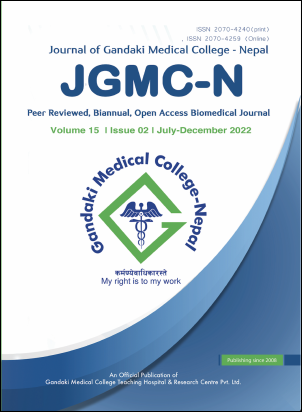The outcome of Transversus Abdominis Release for complex ventral hernia: A one-year of follow-up experience
DOI:
https://doi.org/10.3126/jgmcn.v15i2.47379Keywords:
hernia, incisional hernia, transverse abdominis release, ventral herniaAbstract
Introduction: Transversus Abdominis Release is a noble technique for the repair of complex ventral hernia, where the posterior component separation allows a huge pre-peritoneal space advantageous for the placement of large-sized mesh. It has less wound morbidity as compared to anterior component separation due to the preservation of skin perforators. The main objective of this study was to evaluate one-year follow-up results in terms of recurrence, wound morbidity, and various techniques for managing complications of Transversus Abdominis Release.
Methods: This is a descriptive crosssectional study that was conducted at the department of surgery, College of Medical Sciences Teaching Hospital. Among 41 patients with complex ventral hernia, 34 patients met the inclusion criteria. Demographic data, intra-operative events like bleeding, operative duration, intraoperative complications, post-operative events like duration of hospital stay, wound morbidity, and follow-up data were analyzed.
Results: Posterior rectus sheath closure at midline was possible in 30 (88.2%) patients. In patients, where posterior rectus sheath closure was not possible, the peritoneum of hernia sac was tailored to patch the defect or in some omentum was placed below the raw surface of mesh. The average operative duration and blood losses were 130±12 minutes and 301±133 ml respectively. The semilunar line injury occurred in one case that was diagnosed and repaired at the same time and the TAR plane was re-established. Wound morbidity occurred in three cases that were managed by dressing with commercially available collagen and mupirocin granule. No recurrence was observed in one-year follow-up.
Conclusions: Transversus Abdominis Release has a better result with no recurrence in short term follow up and fewer complications which are easily manageable.
Downloads
Downloads
Published
How to Cite
Issue
Section
License
Copyright (c) 2022 Sagar Khatiwada, Narayan Prasad Belbase, Suman Baral, Hari Prasad Upadhyay, Sushim Bhujel, Nishnata Koirala

This work is licensed under a Creative Commons Attribution-NonCommercial 4.0 International License.
This license allows reusers to distribute, remix, adapt, and build upon the material in any medium or format for noncommercial purposes only, and only so long as attribution is given to the creator.

